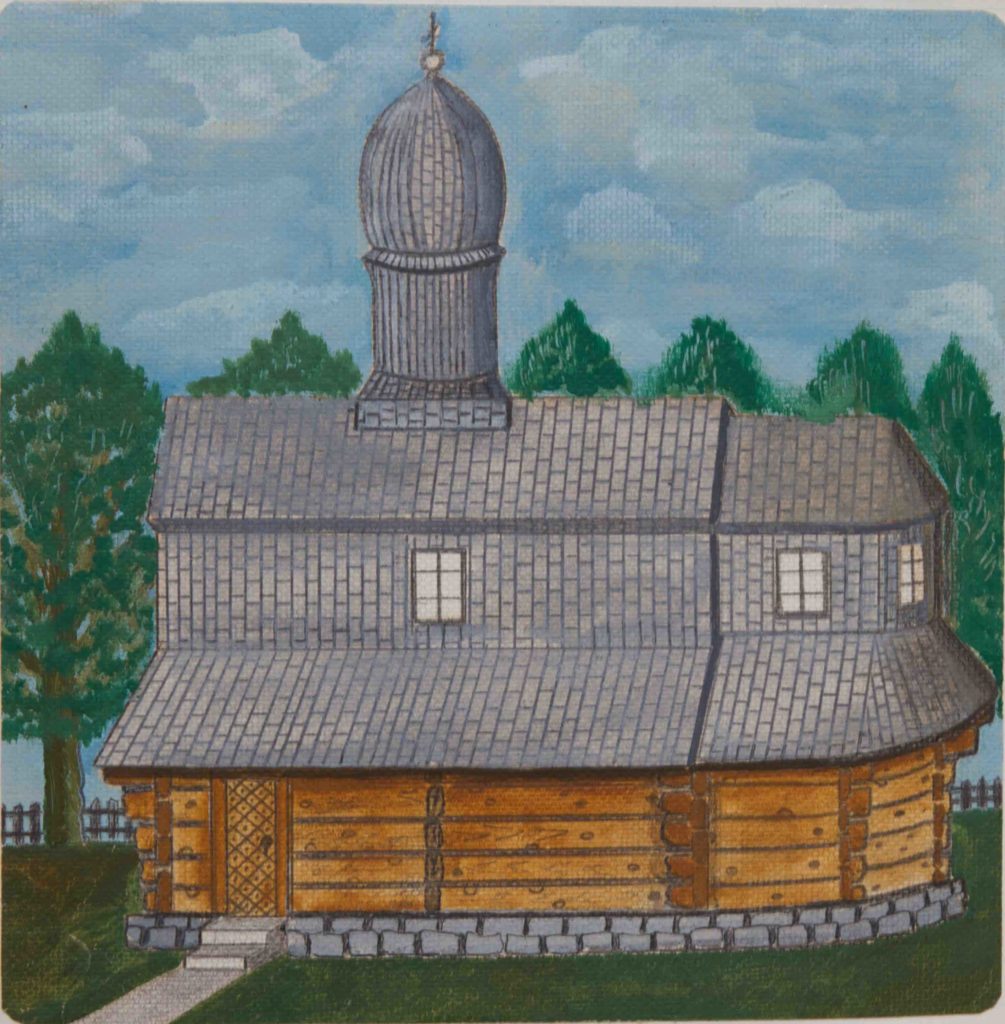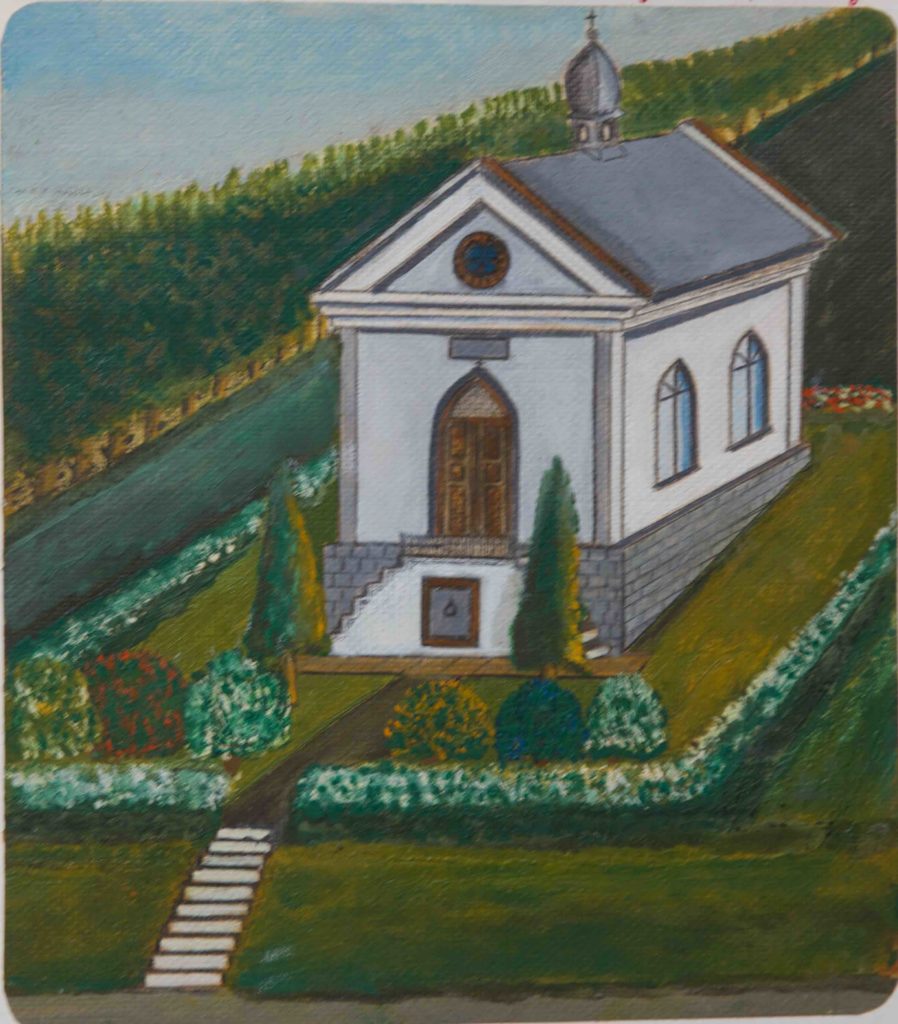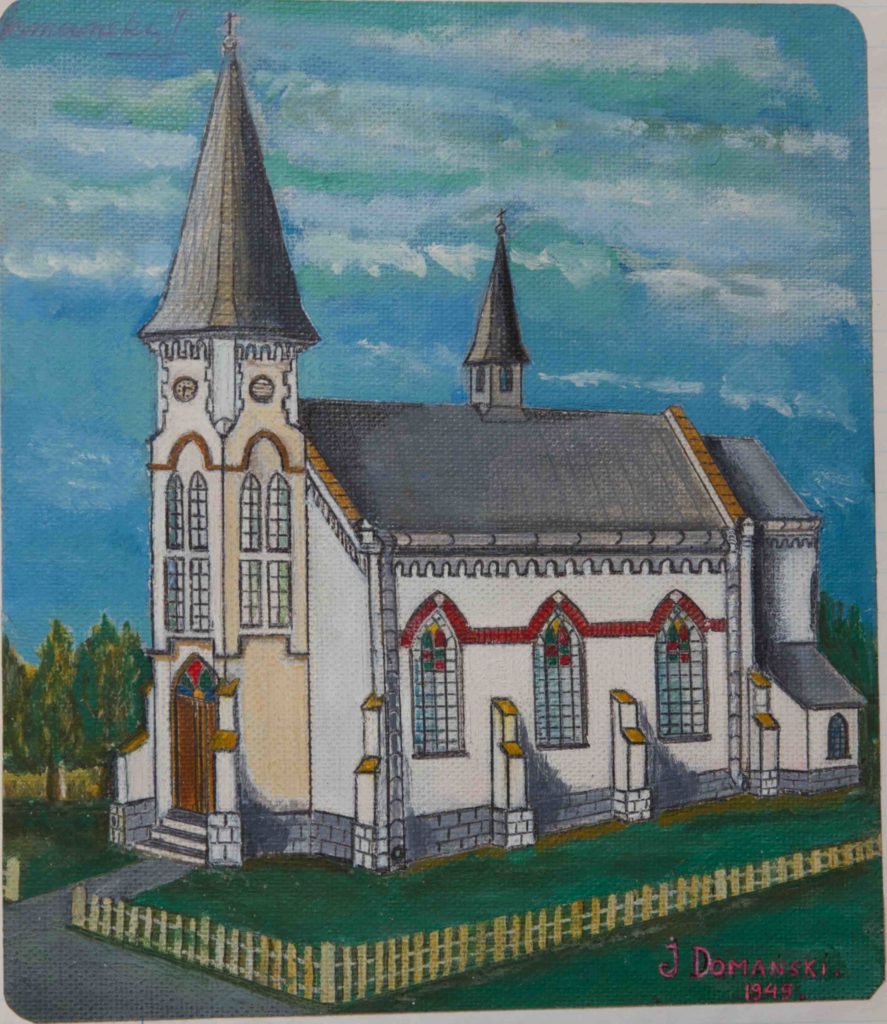History of the Construction of the New Polish Church in Bogdanówka 1910-1914
When I was barely six years old (1908), Poland was abruptly awakening from lethargy. Social reading libraries started forming in the villages. One such a library was located in our house with all sorts of books. Agricultural organizations and patriotic associations such as ‘Bartosz Teams’ and ‘Falcon Divisions’ were forming in the villages and towns. During the long winter evenings Marcin Nowak would read aloud from a book while all the women, either sewing or wounding yarn onto distaffs, would listen late into the night. There were variety of reasons for this movement and awakening of the Polish culture with such a great force. The year 1914 was approaching where an armed conflict was developing between our invaders. It was a call to all the Polish people in the occupied Poland which was partitioned on three separate occasions and longed for freedom. Every city, town and village had something to think and talk about. Bogdanówka was also entangled in her own grievances. In cities such as Lwów (Lviv), Kraków (Cracow) and others, Józef Piłsudski was creating Riflemen Divisions, which was to be the foundation for future legions of the Polish army fighting for independence. It was a tough undertaking and hard work, where we sharpened our swords to one invader while the other was sitting on our backs. This movement of the Polish people was not to the liking of our neighbours, Rusyns or Ukrainians as they prefer to be called today. It was especially distasteful to the Rusyn priests for whom the ground was literally being moved from under their feet. The struggle between the Roman Catholic Church and the Greek-Orthodox grew fiercer from year to year. It was a struggle not only for the souls, as was expressed by both sides, but it was a struggle of the Polish people to regain what was lost during the 126 years of bondage under the three invaders. To start a fight, there had to be some basis, which was soon found between the two competing with each other churches.
As I already mentioned, in Bogdanówka some Polish nobleman built a chapel, which was over three centuries old. It most certainly was built at the heart of a little village. Polish as well as Rusyn people came to pray to this chapel for many years. When the village grew and the chapel became too small, it was expanded by no one else but Mrs. Paprocki. The village population was Polish in majority, as was shown by historical records. After the last partition of Poland and the two uprisings, Poland’s invaders threw a bone of contention between the Polish and Rusyns commoners and the Polish nobility.

It was a commonly accepted among the ordinary people back then in the eastern regions, that Polish language was a language associated with the nobility. Polish snobbish noblemen thought of it as an honour of being distinguished by the invaders like the wheat from the tares. A large percent of this boisterous noble mob did not understand what a huge mistake they were making with respect to the state and its people. The errors made by the nobility and the loathing of simple ignorant people gave very favourable result to the invaders when the Polish language began to fade, and the people of pure Polish blood were slowly assimilated into allegedly peasant, Rusyn language. Many years of such an evolution resulted that the Polish language remained only in the cities and with the nobility. Polish people in the villages were in 60% Ruthenised.
For many years the Polish nobles didn’t care for what was happening, so it was not just the fault of the invaders, but also of our boisterous Polish nobility. It was completely wrong, when someone stated that Malopolska population was 70% Rusyn. Above facts clearly point to what led the Poles in eastern territories to be Ruthenised. There were many people in our area whose names were purely Polish but became Rusyn. Dębicki, Jaworski, Skowroński, Szydłowski, and even Nowak became Rusyn and later Ukrainians. This is why the Polish, Slavic-style chapel after the death of Mrs. Paprocki was converted to Eastern Orthodox church. In rural parishes only Rusyn priests were posted. Polish parishes were only in cities, large towns and only in small percentage in the villages.
When the Hapsburg Emperor, Franz the first, assumed the Austrian throne and was getting ready for the showdown with Russia, he saw the Polish nobles as good allies. He invited members of the Polish Galicia high personalities to the Parliament in Vienna as delegates. As a result of this, the schools within villages suddenly began teaching Polish language and it became the official language in all the counties and provincial offices. Polish priests, from the cities, began visiting numerous villages and raising Polish identity. Their mission however was very difficult, because there were very few Polish churches in the villages. Some that were there, were in the form of historic chapels used by the Rusyns probably for over a hundred years. Rusyn priests, seeing what was happening, were trying to keep the Polish people in their Orthodox church, by saying that, ‘there is only one God.’ As a proof of their sincerity, they appointed Polish men as elder brothers and committee members within the Orthodox churches. Michał Laskowski, a Pole, was in Bogdanówka as an elder brother in the Orthodox church for over forty years.
Another example, which could offend many Polish nationalists, happened around 1900 to an Orthodox priest named Kupczyński who was in the parish of Białkowce and Bogdanówka. Kupczyński was a son of a Polish father and Rusyn mother. His father died when he was only six years old and his mother raised and educated him as an Orthodox priest. Although he was a Rusyn priest, a portion of his blood was Polish, and as a spark at the bottom of his heart glowed and was alive. During Kupczyński tenure large part of the sanctuary and the so-called ‘Tsar gates’ were destroyed by a fire. Kupczyński asked the people for donations to renovate the temple. Rusyns however said, ’if the Poles are older brothers, they should give.’ Polish members made their donations and the church was renovated.
Kupczyński, as a tribute to all the donors or maybe for a different reason, engraved the names of all the donors over the ‘Tsar gates’ in Polish rather then the Cyrillic script. I clearly remember the engraved names of Michał Laskowski, Jan Nowak, Jan Pająk, Michał Marciniszyn, and of two Rusyns Stefan Jaremko and one of the Szamryk. This inscription lasted untouched for a long time, until arrival of a new priest whose name was Fedenyshyn, whom I myself remember a little. Fedenyshyn hated this inscription of the Polish names but he could not simply destroy them. He was afraid of alienating the donors and the Poles from whom he was getting some income. So he begun scraping some of the letters gradually such that the names would loose their Polish identity. Soon the people noticed what was happening and told the priest to stop altering the letters. Some of the Rusyns started defending the priest and because of this, arguments ensued between the Poles and the Rusyns. Fedenyshyn realizing that he was creating a division among the people with his deed, and to keep the Poles on his side, denied as Judas that he was not deforming the sign and that someone else was doing that. This did not calm down the Poles but embittered them even more so. The names remained engraved although somewhat distorted.
It was that way until the time when Hieronim Sykora built a family tomb and over it a beautiful brick chapel. Since there was already a Polish chapel, Polish priest began coming from Jezierna to celebrate Mass here. He began to teach catechism to children in Polish, confess, baptize, bury the dead, give vows and bless food on Easter.

Father Horeczy, the Polish priest from Jezierna, was very active not only within spiritual work but also in patriotic and nationalistic ideals. He was in our area for several years, I was born during his tenure, he taught me catechism and administered my First Communion. A few years before the First World War a fierce battle developed for the Polish parishioners between Fedenyshyn and Horeczy. Father Horeczy with his great sermons aroused the Poles to the love of the Polish language and nationalism.
Fedenyshyn no longer visited Polish homes during Christmas and thus his income decreased considerably which made him angry.
One Holy Saturday, as a youngster, I saw that the Rusyns were carrying food to be blessed (at that time we celebrated Easter at the same time).
“Why we are not taking food to be blessed?” I asked my mother.
“We are not Rusyns and very soon father Horeczy will come to bless our food” was her reply.
I remember, that from then on, the same priest came and blessed food during every Easter and always would take some candies from his cassock and gave it as if to the good children.
Friction between the two priests developed to such an extent that father Horeczy put forth an idea to the Polish people to built their own church. This idea was very quickly adopted. I remember one autumn evening several men gathered in my father’s house and started planning impending construction of the church. They selected the Building Committee, pledged money and afterwords signed some papers. In conclusion, they drank vodka and ate bread with fat bacon. Fat mayor Tomasz (Thomas) Marciniszyn with a huge mustache was talking about some things for a very long time.
“Mom, what are these men going to do?” I asked my mother.
“Can’t you hear, they will be building a church.”
“Where are they going to build it?”
“There by the Rudyk place on the road behind the Orthodox church.”
“And when Mom, tomorrow?”
“Tomorrow, tomorrow! Sit quietly and do not bother me.”
The next morning, a light autumn rain was drizzling when I got up and run to see how they were going to build this church? I was very disappointed when there was not a living soul. My mother laughed wholeheartedly and said, “Oh you silly child, can’t you see that there are no stones or bricks yet. They will build, but not until the next summer.”
During the winter of 1910, farmers begun transporting bricks, stone and sand. My father would leave almost every day with his team of horses to fetch something for the construction. In early spring of 1910 they dug a huge pit and began to make lime bringing water in barrels from the pond. In mid April, an engineer Mr. Łańcucki and an architect Mr. Stawarski arrived with the church plans and began to stake out the trenches for the foundations. Then, whoever was alive came with the shovels to dig deep trenches.
As the work with the church foundations intensified so did the quarrel between the Poles and the Rusyns. One day a large group of Rusyns staged a protest at the construction site to prohibit the construction of the church because it was being built on the municipal road. Police soon arrived and removed the screaming protesters. In fact, it was a municipal road but of little importance, because right beside it was a main road used by the people. The municipal council agreed to eliminate this road and allow the church to be constructed. This resolution was passed beforehand without any difficulty, because the municipal council consisted of Polish majority headed by the Polish mayor. District director was also Polish and he adopted the resolution and approved the plan for the church.
Not every Rusyns was against the construction of the Polish church, however. There were also those who gave donations and transported various materials of construction with their horses and carts.
I remember the day when father Horeczy blessed the foundations and subsequent signing of the dedication by Hieronim Sykora, Doctor Hajny, father Horeczy, engineers Stawarski and Łańcucki, mayor Thomas Marciniszyn and a few officials from the district office. Then again a group of rowdy and loud Rusyns came out waving their arms with threatening gestures at father Horeczy who walked towards them and calmly asked, “Why are you people screaming? Is this new house of God really in your way?”
Then Mrs Hypka Szamryk began to mouth off, (“Poláky, stawyty kostil na dorozi a my kuda budemo jizdyty?”) “You Poles are building your church on the road and which way are we going to go?”
The priest looked at the stupid crone and said, “Do not worry, when you die we will find a road to take your coffin to the graveyard.”
(“A szczobim prodała ciłyj swi majetok to toj kościół ne budy stojaty. Stawty a ja sprowadżu kanona i jeho rozwalu.”) “Even if I had to sell all of my possessions, this church will not be standing. You can build and I will bring a canon and will destroy it.”
The priest at these stupid words laughed out loud and said,
“You know woman, that your stupid head will burst much sooner before the walls of the church.”
Construction with the help of God and generosity of the people from Bogdanówka and from the local and even the distant villages and towns, progressed quite well.
The owner of goods in Pruniatyn donated stone for the entire church underpinning. Directorate of Railway gave the stone for the foundations. Count Cieński from Pieniak donated the wood from his forests for burning of bricks. Mr. Sykora and Mr. Hajny, being part of the church construction committee, also donated their portion. Episcopate in Lwow and Directorate in Zborow also contributed.
An estimate for the construction of the church came to about 40,000 Austrian crowns, which for 45 Polish families in Bogdanówka was a substantial sum or about 1000 crowns per family. If not for the generosity of people from distant areas, the construction of such a building would have been very difficult. Construction which started in the spring of 1910, wound down in 1913. On top of a beautiful church, within rural houses surrounded with greenery, dominated a slender Gothic tower crowned with a cross which shone in the sun to the glory of God and to the pride of the village.
Father Horeczy was here several times a week during the construction. He was the main mastermind and motivator of the local wealthy and common people who so generously contributed to the construction.

In the spring of 1914 the church was plastered inside, windows and doors were framed and a makeshift altar was raised. Just before the outbreak of the First World War, the church was officially dedicated to Our Lady of the Scapular (Kościół Matki Boskiej Szkaplerznej) and opened for daily use. After four years of hard work of our fathers the church was almost finished.
Mrs Hypka Szamryk somehow did not bring any canons as she swore to do. In later years, she lost all of her property but the church stood and still stands today after surviving two terrible wars.
Jan Domański
Translated by: John Janiga
Leave a Reply